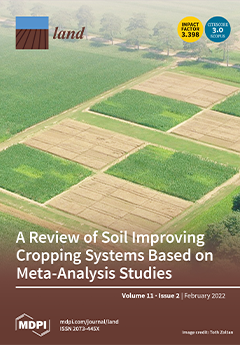As atmospheric carbon dioxide concentrations, [CO
2Air], continue their uncontrolled rise, the capacity of soils to accumulate or retain carbon is uncertain. Free-air CO
2 enrichment (FACE) experiments have been conducted to better understand the plant, soil and ecosystem response to elevated [CO
2], frequently employing commercial CO
2 that imparts a distinct isotopic signal to the system for tracing carbon. We conducted a FACE experiment in 1998 and 1999, whereby sorghum (C
4 photosynthetic pathway) was grown in four replicates of four treatments using a split-strip plot design: (i) ambient CO
2/ample water (365 μmol mol
−1, “Control–Wet”), (ii) ambient CO
2/water stress (“Control–Dry”), (iii) CO
2-enriched (560 μmol mol
−1, “FACE–Wet”), and (iv) CO
2-enriched/water stressed (“FACE–Dry”). The stable-carbon isotope composition of the added CO
2 (in FACE treatments) was close to that of free atmosphere background values, so the subsequent similar
13C-enriched carbon signal photosynthetically fixed by C
4 sorghum plants could be used to trace the fate of carbon in both FACE and control treatments. Measurement of soil organic carbon content (SOC (%) = g
C/g
dry soil × 100%) and δ
13C at three depths (0–15, 15–30, and 30–60 cm) were made on soils from the beginning and end of the two experimental growing seasons. A progressive ca. 0.5‰–1.0‰ δ
13C increase in the upper soil SOC in all treatments over the course of the experiment indicated common entry of new sorghum carbon into the SOC pools. The 0–15 cm SOC in FACE treatments was
13C-enriched relative to the Control by ca. 1‰, and according to isotopic mass balance, the fraction of the new sorghum-derived SOC in the Control–Wet treatment at the end of the second season was 8.4%, 14.2% in FACE–Wet, 6.5% in Control–Dry, and 14.2% in FACE–Dry. The net SOC enhancement resulting from CO
2 enrichment was therefore 5.8% (or 2.9% y
−1 of experiment) under ample water and 7.7% (3.8% y
−1 of experiment) under limited water, which matches the pattern of greater aboveground biomass increase with elevated [CO
2Air] under the Dry treatment, but no parallel isotopic shifts were found in deeper soils. However, these increased fractions of new carbon in SOC at the end of the experiment do not necessarily mean an increase in total SOC content, because gravimetric measurements of SOC did not reveal a significant increase under elevated [CO
2Air], at least within the limits of SOC-content error bars. Thus, new carbon gains might be offset by pre-experiment carbon losses. The results demonstrate successful isotopic tracing of carbon from plants to soils in this sorghum FACE experiment showing differences between FACE and Control treatments, which suggest more dynamic cycling of SOC under elevated [CO
2Air] than in the Control treatment.
Full article





